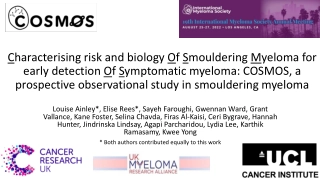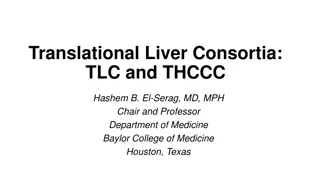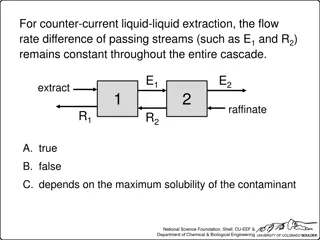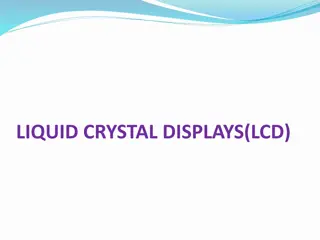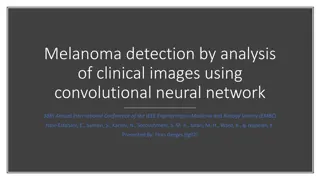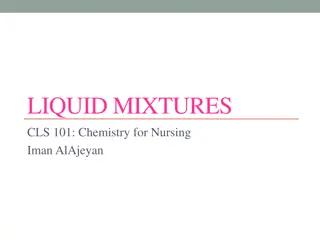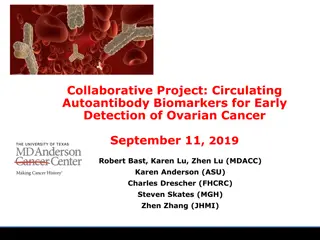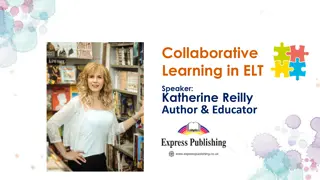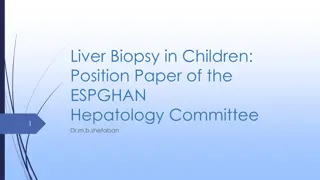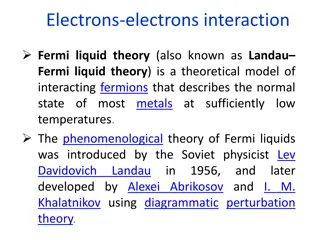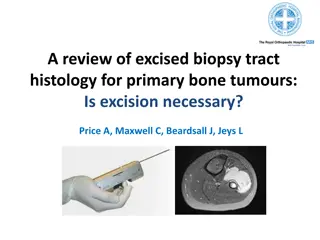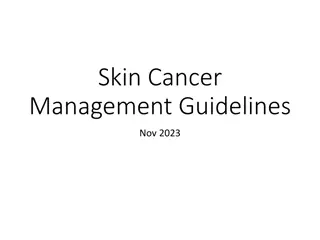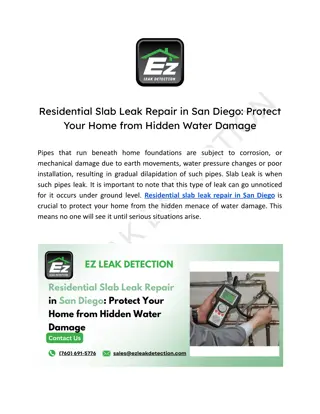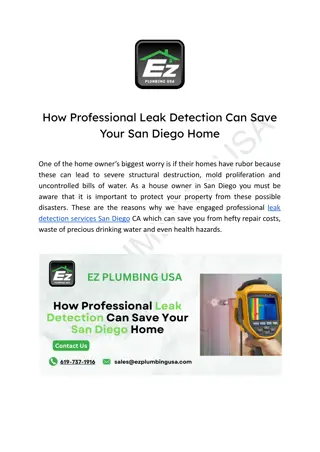Collaborative Efforts in Liquid Biopsy for Early Detection
This presentation by Dr. James C. Willey discusses the FDA collaborative on next-gen sequencing and its relevance to liquid biopsy for early cancer detection. The focus is on issues with current testing methods, study objectives to improve diagnostic guidelines, and developing reference samples for oncopanel sequencing.
Download Presentation

Please find below an Image/Link to download the presentation.
The content on the website is provided AS IS for your information and personal use only. It may not be sold, licensed, or shared on other websites without obtaining consent from the author.If you encounter any issues during the download, it is possible that the publisher has removed the file from their server.
You are allowed to download the files provided on this website for personal or commercial use, subject to the condition that they are used lawfully. All files are the property of their respective owners.
The content on the website is provided AS IS for your information and personal use only. It may not be sold, licensed, or shared on other websites without obtaining consent from the author.
E N D
Presentation Transcript
FDA Collaborative on Next Gen Sequencing and its Relevance to Liquid Biopsy for Early Detection James C. Willey, MD George Isaac Chair for Cancer Research Medical Director, Eleanor N. Dana Cancer Center University of Toledo Co-Founder, Inventor, Medical Advisor Accugenomics, Inc. James.willey2@utoledo.edu Disclaimer: This presentation reflects the views of the presenter and should not be construed to represent FDA sviews or policies.
Issues and Our Collaborative Effort FDA approved several NGS tests with sensitivity for AF ~5% Hundreds lab developed tests (LDT): sensitivity ~ 2-10% FDA approved ctDNA (LBx) tests with sensitivity for AF ~0.3% Publications claimed detection sensitivity for deep NGS tests (of ctDNA through UMI) could reach lower AF and even 0.01% Lack of concordance reported b/w liquid biopsy test labs Key concerns for LBx:concordance with tissue sequencing, concordance across labs, concordance across LBx panels/tests Comprehensive QC with Reference Samples is crucial for translating oncopanels from lab dev to clinical application !!! 2
Study Objectives Identify LBx (ctDNA) diagnostic testing best-practice guidelines for current standard of care Evaluate analytical performance characteristics of LBx tests in artificial ctDNA samples Reproducibility: Inter-lab, inter-replicate Sensitivity to detect Known Positives Specificity: False positive rate: estimated through Known Negatives Performance measured according to VAF ranges Evaluate impact on analytical performance of DNA amount loaded into assay Median fragment depth following panel enrichment and UMI library prep Evaluateuse of synthetic internal standard spike-ins Do they improve quality control beyondcurrent standard of care for variant calling in ctDNA testing 3
Developing Reference Samples for Oncopanel Seq A Verified Genomic Reference Sample for Assessing Performance of Cancer Panels Detecting Small Variants of Low Allele Frequency Sample A: Mixture of 10 UHRR cancer cell line gDNA. Truth set includes 42,000 variants (Known Positives) and over 10 million negative positions (Known Negatives) across 22 Mb exonic coding regions VAF distribution of known variants 400 ddPCR validation assays. Concordance >99.5% Manuscript in press at Genome Biology Sample A SampleB Mix A:B Sample B - Agilent Male DNA Control (Product #: 51903796): to minimize mutation background and maximize homogeneity. Cross-oncopanelstudy reveals high sensitivity and accuracy with overall analytical performance depending on genomic regions: Accepted by Genome Biology SampleE 1:24 25xdil SampleD 1:4 5xdil 4
Artificial Liquid Biopsy (ct-DNA) samples for cross-lab study Bf_25 | Df_25 | Ef_10 Ef_25 | Ef_50 | Ep_25 Centralized sample preparation Enzymatic fragmentation Bf,Df,Ef Gel-based size selection (160bp- 180bp) to mimic cfDNA 6Samples 5 ROC BRP TFS ILM IDT PANELS BRP: Burning Rock Dx LungPlasma v4 IDT: Integrated DNA Technologies (IDT) xGen Non-Small Cell Lung Cancer 1ng/ul to mimic concentration after DNA extraction from plasma Samples tested 10ng, 25ng, or 50ng samplesin buffer 25 ng sample in artificial plasma (Ep25) ILM: Illumina TruSight 170 with UMI ROC: Roche AVENIO ctDNA Expanded Kit TFS: ThermoFisher Oncomine Lung cfDNA Assay UniqueMolecularIndex (UMI) librarypreparationafte5r hybrid capture enrichment
LBx Cross-lab Study Design Reproducibility Bf_25 | Df_25 | Ef_10 Ef_25 | Ef_50 | Ep_25 6Samples Variantcalls in vcf files 1 2 3 Variantcalls in vcf files 1 2 3 Variant calls in vcffiles 1 2 3 5 ROC BRP TFS ILM IDT 4 4 4 PANELS Intra-lab reproducibility Cross-lab reproducibility 3 TestLabs perPanel Lab1 Lab2 Lab3 Sensitivityand FalsePositive Rate 4Replicates perTestLab Lib1 Lib2 Lib3 Lib4 Lib1 Lib2 Lib3 Lib4 Lib1 Lib2 Lib3 Lib4 Known Positives Variantcalls Known Negatives TP Sequencing Each panel vendor runs its variant calling pipeline FP 6
Variation in Median Fragment Depth Following Panel Enrichment and UMI Library Prep: Causes and Effects on Analytical Performance Median fragment depth yield Linearly correlated with the DNAinput Inter-panel variation in yield associated with size of panel For ~7250 copies loaded (25 ng) Yield varied from 1000 4500 genome copies (~15% - 60% recovery). Inter-panel variation in median fragment depth Effect of panel-specific median fragment depth and VAF on AnalyticalPerformance Sensitivity Conclusions: For variants with VAF below 0.5%, higher median fragment depth associated with better Sensitivity Reproducibility Specificity Reproducibility Specificity 7
Key findings from Study of Commercial LBx Platforms Generally high precision and reproducibility for all 5 platforms Detectionof mutations below ~0.5% Generally unreliable Varied widely between panel providers Worse performance wheninput material was limited (i.e., 10ng). With 50ng (15,500 genome copies) and associated higher median depth, good performance can be achieved with VAF above 0.3%. Missed mutations (false-negatives) were more common than erroneous candidates (false-positives), due to random sampling. Fragment-depth was a criticalvariable High coverageessential for sensitive detection of low-frequencymutations Even coverage across target region important to ensure high sensitivity and reproducibility. 8
Advancing quality-control for NGS measurement of actionable mutations in circulating tumor DNA Internal Standard Spike-In MoleculesControl for Technical Error Nucleotide-specific technical error in IS is reproducible Error at each NT base positionmatches corresponding IS position IS controls for intra- and inter-panel variation in hybridizationefficiency(EGFR as example) Craig et al, BMC Cancer 2019 Blomquistet al, BDQ2015 Spiking IS into each reaction also controls for sources of variation within library prep Interfering substances Ligation efficiency Amplification
Applying Internal Standards to Artificial ctDNA Samples Samples B, D, and E were enzymatically fragmented to mimic circulating tumor DNA found in liquid biopsies (SamplesBf, Df,Ef). Synthetic internal standards were enzymatically fragmented and mixed in equal amounts to each liquid biopsy sample to createSamplesBfIS, DfIS, EfIS.
SnaqSeq Method Pipeline Mix IS with each sample Hybrid capture panel enrichment followed by library prep Illumina sequencing: FASTQ files analyzed Custom script used to separate NT from IS reads with 99.9997% efficiency Initial variant call (VarDict or panel specific variant caller) NT gVCF file and IS gVCF file used in Poisson Exact Test analysis for SNAQ-SEQ calls Compare NT depth and alt counts, and IS depth and alt counts 11
SnaqSeq Method Development Establish Ground truth Serially dilute SampleA in SampleB Roche pancancer panel enrichment Illumina deep sequencing 28 known positive variants within sequence spanned by IS mixture 3500 known negative positions: do not respond to titration Panel A 5608 Sample A NT variants with matched variant in IS sequence were plotted NT variants calledby VarDict are indicatedas significant (green filled) or not significant(red) by SNAQ-SEQ QC PET analysis Variantsnot called by VarDict or SNAQ-SEQ QC PET analysisare indicatedas grey circles. Panels B and C Determinelimit of blank (LOB) and limit of detection based on PET analysis LOB: Based on the IS sequencingdepthand variantallele frequency NT variantsignificancebased on PET score. A B C 1 2
SnaqSeq Method Validation: Effect of SNAQ-SEQ QC on UMI VCF file variants from Samples DfIS and EfIS (blue commercial panel provider) Four replicate library preparations Samples DfISand EfIS Target enrichment on panel from blue panel provider UMI library preps Panel provider pipeline gVCFforNT and IS Variants called either PASS or LowSupport SNAQ-SEQ PET analysis Identify LOB for each NT variant based on PET analysisofIS Determine significance of NTvariantsindependently of panel provider calls Results Panel a: SNAQ-SEQ analysis of panel provider VCF PASS and Low-Support variants SNAQ-SEQcalled variants indicated as green columns,not called as red columns Panel b and c: Panel provider VCF PASS and LowSupport variants displayed Panel b: NT variant VAFon y-axis and matched ISvariant VAFon x-axis. Panel c: NT variant VAFon y-axisand matched ISdetermined LOB on x-axis 1 3
Assessment of SnaqSeq Clinical Utility Summary Use of synthetic IS enabled: Calculation of technical error at each nucleotide position in each sample analysis PET analysisto determine LOB and LOD, and significance of each variant measured in sample With SNAQ-SEQ QC PET analysis Panel provider pipelineLow-Support true positive variants were salvaged One panelprovider PASS true positive was not calledby SNAQ-SEQ analysis SNAQ-SEQ QC PET analysis increased sensitivity to call true positive variants by 13% in among variants with VAF 0.1-0.3% 1 4
Going forward LBx (ctDNA) diagnostic testing best-practice guidelines for current standard of care. Deveson et al manuscript accepted by Nat Biotech Will release all study data (including raw seq data) Standardized reference sampleswith ground truth known positives and negatives Jones et al SEQC2 reference sample manuscript accepted by Genome Biology Samples will be marketed by Agilent. Unfortunately delayed by COVID-19 Use of synthetic internal standardspike-ins to improve quality control beyond current standard of care for variant callingin ctDNA testing Willey et al manuscript submitted Best practice guidelines for analysis of FFPE samples Blomquist et al, manuscript under review at Cell Genomics SEQC2Consortium Follow-up benchmarking of more assays and DNA extraction methods 15
Acknowledgements SEQC2 Leadership Team Drs. Joshua Xu (FDA), Weida Tong (FDA) and Leming Shi (Fudan University, China) All members of SEQC2 Oncopanel Sequencing Working Group Accugenomics, Inc.: Accukit TomMorrison, PhD synthetic internal standards Agilent, Inc.: Agilent Reference Samples Departments of Medicine and Pathology, University of Toledo Dan Craig, Phd, Erin Crawford, MS, Tom Blomquist, MD/PhD Q2 Solutions: Illumina sequencing services Wendell Jones, PhD Funding NCI EDRN U24 CA086368-17 sub-award 00009213 NIHGR: 5U01CA243483-02 sub-award George Isaac Chair for Cancer Research 16


